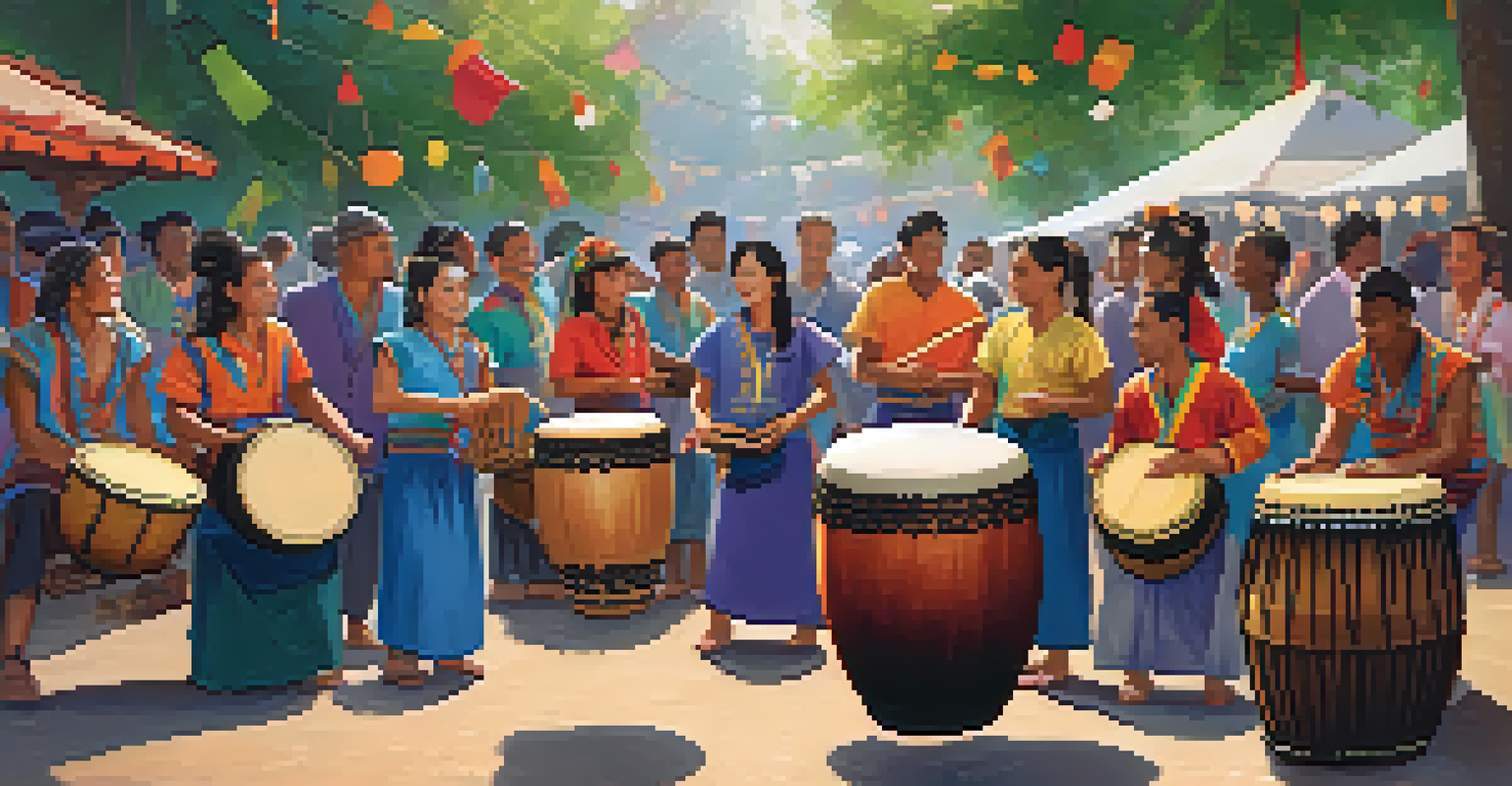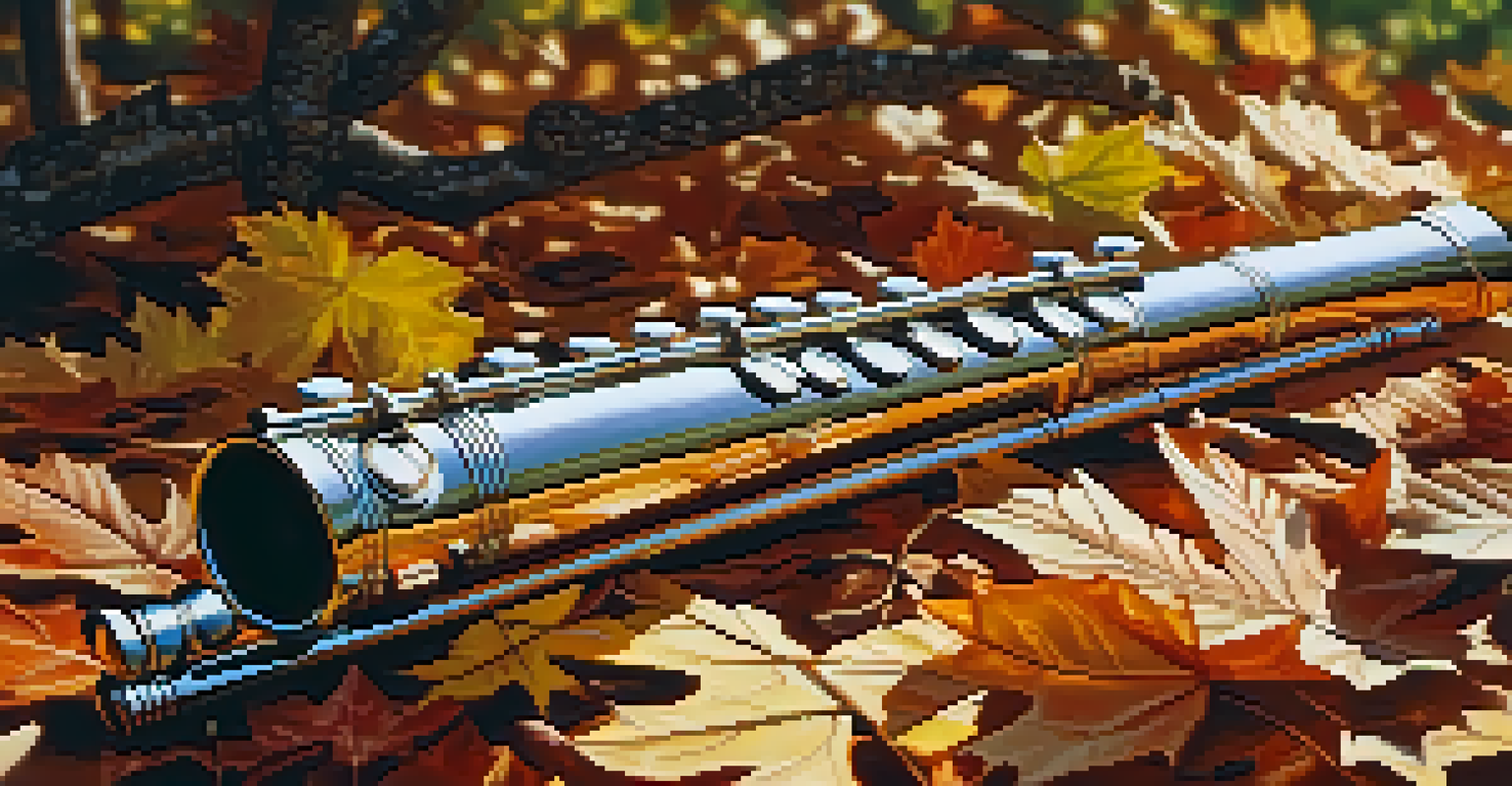Traditional Instruments and Their Cultural Significance Globally

The Heartbeat of Cultures: Understanding Traditional Instruments
Traditional instruments are more than just tools for making music; they are vital expressions of cultural identity. Each instrument carries a story, reflecting the values, beliefs, and history of the communities that create and use them. From the haunting melodies of the Irish Uilleann pipes to the vibrant rhythms of the African djembe, these instruments resonate with the spirit of their origins.
Music is the shorthand of emotion.
In many cultures, traditional instruments are used during significant events such as weddings, festivals, and religious ceremonies. They help convey emotions, celebrate life, and connect generations. For instance, the didgeridoo of Australia is not just a musical instrument; it also plays a crucial role in Aboriginal rituals, symbolizing the connection to the land and ancestors.
As globalization continues to influence music, traditional instruments often blend with modern styles, creating unique new sounds. However, preserving their cultural significance is essential, reminding us of the rich tapestry of human expression that each instrument represents.
Strings Attached: The Role of String Instruments Worldwide
String instruments, such as the sitar in India and the lute in the Middle East, are deeply embedded in their respective cultures. The sitar, for example, is not only a musical instrument but a vehicle for spiritual expression in classical Indian music, often used in performances that evoke deep emotions. Similarly, the lute has been a staple in Middle Eastern music for centuries, connecting listeners to their historical narratives.

These instruments are often handcrafted, showcasing the artisan's skill and cultural heritage. The craftsmanship involved in creating string instruments reflects the values of patience and dedication that are integral to both the maker and the culture it represents. Each instrument tells a story, from the choice of wood to the intricate designs that adorn them.
String instruments also play a vital role in storytelling traditions, where music complements oral histories. Through their melodies, they help preserve folklore and myths, ensuring that valuable cultural narratives continue to echo through generations.
Percussion Instruments: The Pulse of Global Cultures
Percussion instruments serve as the heartbeat of many cultures, providing rhythm and energy to music that brings people together. Drums, such as the African djembe and the Japanese taiko, are often central to community gatherings and celebrations. They create a sense of unity, inviting everyone to participate in the collective experience of music and dance.
The roots of music are deep in the human experience, and they remind us of the stories that connect us all.
These instruments are not merely for entertainment; they also hold significant cultural rituals and practices. For instance, the use of drums in Native American ceremonies is crucial for spiritual connection and communal bonding. Each beat resonates with the heartbeat of the earth, reminding participants of their ties to nature and each other.
The evolution of percussion instruments has seen them integrated into various music genres, from jazz to pop. Yet, the essence of their cultural significance remains intact, reminding us that rhythm is a universal language that transcends borders and unites diverse communities.
Wind Instruments: Breathing Life into Traditions
Wind instruments, such as the Native American flute and the Chinese erhu, are often associated with storytelling and spiritual practices. The sounds they produce evoke emotions and create atmospheres that resonate with listeners on a deeper level. For instance, the haunting notes of the Native American flute are often used in meditation, helping to foster a connection to nature and the spirit world.
In many cultures, wind instruments are used to communicate messages, celebrate events, or accompany dances. The Scottish bagpipes, for example, are not just played at celebrations but also during somber occasions, reflecting the full spectrum of human experience. Their powerful sound can evoke feelings of pride and nostalgia.
The craftsmanship involved in creating wind instruments is often steeped in tradition, with each instrument reflecting the culture's values and aesthetics. From the materials chosen to the techniques employed, these instruments are a testament to the rich heritage of the communities that cherish them.
Brass Instruments: Heralding Cultural Heritage
Brass instruments, such as trumpets and tubas, have a unique place in many cultural traditions, often associated with celebrations and ceremonies. The vibrant sound of a trumpet can signify joy and festivity, making it a staple in parades and celebrations across different cultures. For example, in New Orleans, brass bands are essential for Mardi Gras, bringing the streets to life with their energetic performances.
These instruments also carry historical significance, often linked to military and royal ceremonies. The bugle, for instance, has been used for centuries to signal troops during battle, symbolizing bravery and honor. Its distinct sound can evoke a sense of pride and nostalgia, reminding listeners of the past.
Moreover, brass instruments often blend with other musical styles, contributing to the evolution of genres like jazz and ska. This adaptability highlights their importance in contemporary music while maintaining ties to their cultural roots.
Impact of Modern Technology on Traditional Instruments
As technology advances, traditional instruments are finding new life in modern music. Musicians are increasingly experimenting with electronic effects, blending the sounds of traditional instruments with contemporary genres. This fusion creates a unique auditory experience, allowing traditional sounds to reach new audiences and evolve.
However, this blend comes with challenges. Some purists worry that the essence and cultural significance of these instruments may be lost in the process. It’s crucial to strike a balance between innovation and preservation, ensuring that the rich histories tied to these instruments are respected while embracing new possibilities.
Educational initiatives and digital platforms have emerged to help preserve traditional music. Online tutorials and virtual collaborations allow musicians from different backgrounds to connect, share, and learn from one another, fostering a greater appreciation for the cultural significance of traditional instruments worldwide.
Preserving Cultural Significance Through Education and Community
Education plays a vital role in preserving the cultural significance of traditional instruments. Music schools and community programs dedicated to teaching these instruments help ensure that the knowledge and skills are passed down through generations. This not only keeps the music alive but also instills a sense of pride and identity within communities.
Moreover, community events and festivals celebrating traditional music encourage participation and appreciation. These gatherings provide a platform for musicians to showcase their skills and for audiences to experience the richness of their cultural heritage firsthand. The shared joy of music fosters connections that strengthen community bonds.

By supporting organizations and initiatives that prioritize traditional music education, we contribute to the preservation of cultural identities worldwide. Understanding and appreciating these instruments is crucial, as they are not just musical tools but essential threads in the fabric of our global heritage.